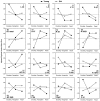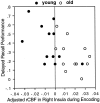Age-related differences in neural activity during memory encoding and retrieval: a positron emission tomography study
- PMID: 8987764
- PMCID: PMC6793692
- DOI: 10.1523/JNEUROSCI.17-01-00391.1997
Age-related differences in neural activity during memory encoding and retrieval: a positron emission tomography study
Abstract
Positron emission tomography (PET) was used to compare regional cerebral blood flow (rCBF) in young (mean 26 years) and old (mean 70 years) subjects while they were encoding, recognizing, and recalling word pairs. A multivariate partial-least-squares (PLS) analysis of the data was used to identify age-related neural changes associated with (1) encoding versus retrieval and (2) recognition versus recall. Young subjects showed higher activation than old subjects (1) in left prefrontal and occipito-temporal regions during encoding and (2) in right prefrontal and parietal regions during retrieval. Old subjects showed relatively higher activation than young subjects in several regions, including insular regions during encoding, cuneus/precuneus regions during recognition, and left prefrontal regions during recall. Frontal activity in young subjects was left-lateralized during encoding and right-lateralized during recall [hemispheric encoding/retrieval asymmetry (HERA)], whereas old adults showed little frontal activity during encoding and a more bilateral pattern of frontal activation during retrieval. In young subjects, activation in recall was higher than that in recognition in cerebellar and cingulate regions, whereas recognition showed higher activity in right temporal and parietal regions. In old subjects, the differences in blood flow between recall and recognition were smaller in these regions, yet more pronounced in other regions. Taken together, the results indicate that advanced age is associated with neural changes in the brain systems underlying encoding, recognition, and recall. These changes take two forms: (1) age-related decreases in local regional activity, which may signal less efficient processing by the old, and (2) age-related increases in activity, which may signal functional compensation.
Figures





Similar articles
-
The effect of divided attention on encoding and retrieval in episodic memory revealed by positron emission tomography.J Cogn Neurosci. 2000 Mar;12(2):267-80. doi: 10.1162/089892900562093. J Cogn Neurosci. 2000. PMID: 10771411
-
Aging and recognition memory: changes in regional cerebral blood flow associated with components of reaction time distributions.J Cogn Neurosci. 1999 Sep;11(5):511-20. doi: 10.1162/089892999563571. J Cogn Neurosci. 1999. PMID: 10511640
-
Visual memory, visual imagery, and visual recognition of large field patterns by the human brain: functional anatomy by positron emission tomography.Cereb Cortex. 1995 Jan-Feb;5(1):79-93. doi: 10.1093/cercor/5.1.79. Cereb Cortex. 1995. PMID: 7719132 Clinical Trial.
-
The functional neuroanatomy of episodic memory: the role of the frontal lobes, the hippocampal formation, and other areas.Neuroimage. 1998 Aug;8(2):198-213. doi: 10.1006/nimg.1998.0359. Neuroimage. 1998. PMID: 9740762 Review.
-
Noun and verb retrieval by normal subjects. Studies with PET.Brain. 1996 Feb;119 ( Pt 1):159-79. doi: 10.1093/brain/119.1.159. Brain. 1996. PMID: 8624678 Review.
Cited by
-
Where is ELSA? The early to late shift in aging.Cereb Cortex. 2012 Nov;22(11):2542-53. doi: 10.1093/cercor/bhr334. Epub 2011 Nov 23. Cereb Cortex. 2012. PMID: 22114083 Free PMC article.
-
Age-Related Influences of Prior Sleep on Brain Activation during Verbal Encoding.Front Neurol. 2012 Apr 3;3:49. doi: 10.3389/fneur.2012.00049. eCollection 2012. Front Neurol. 2012. PMID: 22493590 Free PMC article.
-
Brain activation patterns in patients with post-stroke cognitive impairment during working memory task: a functional near-infrared spectroscopy study.Front Neurol. 2024 Aug 12;15:1419128. doi: 10.3389/fneur.2024.1419128. eCollection 2024. Front Neurol. 2024. PMID: 39188710 Free PMC article.
-
Vulnerable neural systems and the borderland of brain aging and neurodegeneration.Neuron. 2013 Jan 23;77(2):219-34. doi: 10.1016/j.neuron.2013.01.002. Neuron. 2013. PMID: 23352159 Free PMC article. Review.
-
Compensatory brain activity during encoding among older adults with better recognition memory for face-name pairs: an integrative functional, structural, and perfusion imaging study.J Int Neuropsychol Soc. 2012 May;18(3):402-13. doi: 10.1017/S1355617712000197. Epub 2012 Mar 20. J Int Neuropsychol Soc. 2012. PMID: 22433609 Free PMC article.
References
-
- Cabeza R, Nyberg L (1996) Imaging cognition: an empirical review of PET studies with normal subjects. J Cognit Neurosci, in press. - PubMed
-
- Cabeza R, Kapur S, Craik FIM, McIntosh AR, Houle S, Tulving E (1996) Functional neuroanatomy of recall and recognition: a PET study of episodic memory. J Cognit Neurosci, in press. - PubMed
Publication types
MeSH terms
LinkOut - more resources
Full Text Sources
Medical
